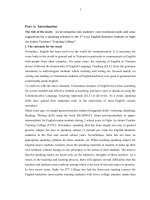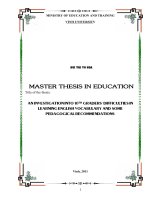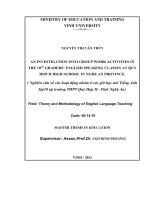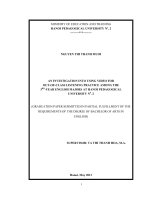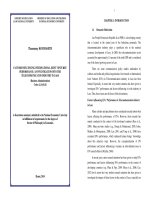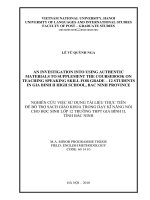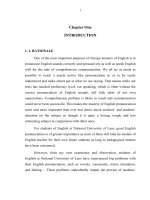An investigation into using situational contexts in teaching grammar for non-English major freshmen in a university in Nam Dinh city
Bạn đang xem bản rút gọn của tài liệu. Xem và tải ngay bản đầy đủ của tài liệu tại đây (1.06 MB, 71 trang )
VIETNAM NATIONAL UNIVERSITY, HANOI
UNIVERSITY OF LANGUAGES AND INTERNATIONAL STUDIES
FACULTY OF POST-GRADUATE STUDIES
******
LẠI THỊ HIỀN
AN INVESTIGATION INTO USING SITUATIONAL
CONTEXTS IN TEACHING GRAMMAR FOR
NON-ENGLISH MAJOR FRESHMEN IN A UNIVERSITY
IN NAM DINH CITY
(Nghiên cứu việc sử dụng ngữ cảnh tình huống vào giảng dạy ngữ
pháp cho sinh viên không chuyên Tiếng Anh năm thứ nhất tại một
trường đại học ở thành phố Nam Định)
M.A. MINOR PROGRAMME THESIS
Field: English Teaching Methodology
Code: 60.140.111
HANOI - 2014
VIETNAM NATIONAL UNIVERSITY, HANOI
UNIVERSITY OF LANGUAGES AND INTERNATIONAL STUDIES
FACULTY OF POST-GRADUATE STUDIES
******
LẠI THỊ HIỀN
AN INVESTIGATION INTO USING SITUATIONAL
CONTEXTS IN TEACHING GRAMMAR FOR
NON-ENGLISH MAJOR FRESHMEN IN A UNIVERSITY
IN NAM DINH CITY
(Nghiên cứu việc sử dụng ngữ cảnh tình huống vào giảng dạy ngữ
pháp cho sinh viên không chuyên Tiếng Anh năm thứ nhất tại một
trường đại học ở thành phố Nam Định)
M.A. MINOR PROGRAMME THESIS
Field: English Teaching Methodology
Code: 60.140.111
Supervisor: Dr. Hà Cẩm Tâm
HANOI - 2014
DECLARATION
I hereby certify that the thesis entitled
AN INVESTIGATION INTO USING SITUATIONAL CONTEXTS IN TEACHING
GRAMMAR FOR NON-ENGLISH MAJOR FRESHMEN IN A UNIVERSITY IN
NAM DINH CITY
Is the result of my own research for the Degree of Master at University of
Languages and International Studies, Hanoi National University, and that this thesis has
not been submitted for any degree at any other upper secondary schools.
Hanoi, August 20th, 2008
Lại Thị Hiền
i
ACKNOWLEDGEMENTS
This thesis could not have been completed without the help, encouragement and support
of a number of people who all deserve my sincere gratitude and appreciation.
First of all, I would like to express my deepest gratitude to my supervisor, Dr. Ha Cam
Tam for her enthusiastic help and guidance.
I am also very grateful to all of my students of the class CDDI22A2 at University of
Economics and Technical Industry (UNETI), who participated in my action research. This
contribution played a very important role in my research‟s result.
I would like to send my special thanks to my lecturers, my friends and my classmates for
their sincere comments and criticism.
Finally, a special word of thanks goes to my readers for their interest and comments on
this study.
ii
ABSTRACT
In order to be fluency in English, grammar is considered to be the basis to develop other
four skills. However, when teaching grammar to first-year students at University of
Economics and Technical Industry, the author of this research found out that students
were not interested in learning grammar. Hence, they did not focus on the lesson and
ignored doing exercises resulting in bad marks in the tests and exams. Thanks to the
reasons above, the researcher decided to use situational contexts to teach grammar for
students. The aims of carrying out this research were to find out students‟ interest in
grammar lessons which apply situational contexts and measure whether students can
complete grammar exercises better after practicing with situational contexts. In order to
do this research, the researcher first makes plans for the study by preparing situational
contexts and deciding how they are applied in the classroom. Then, the action stage takes
place. All the situational contexts are put into practice. The teacher gives them to students
and they have to make presentation about those situational contexts. During this stage, all
things happened in the class are observed and taken notes. At the same time, after each
try-out lesson, there is a test given at the end of the lesson in order to measure students‟
progress. Last but not least, the action is evaluated by analyzing and comparing the results
of the test and summarizing and discussing the observation notes. In the end, the
researcher gives comments and conclusions about the study.
iii
TABLE OF CONTENTS
PART A: INTRODUCTION ................................................................................................ 1
1. Rationale of the study ............................................................................................. 1
2. Objectives of the study............................................................................................ 2
3. The research questions ............................................................................................ 2
4. The scope of the study ............................................................................................ 2
5. The significance of the study .................................................................................. 3
6. Methods of the study ............................................................................................... 3
7. Organization of the study ........................................................................................ 3
PART B: DEVELOPMENT................................................................................................. 5
CHAPTER 1: LITERATURE REVIEW .......................................................................... 5
1.1.
Grammar .............................................................................................................. 5
1.1.1.
Theoretical background about grammar ....................................................... 5
1.1.1.1. Definitions of grammar ............................................................................. 5
1.1.1.2. The importance of grammar in second language teaching ........................ 6
1.1.2.
Approaches in grammar teaching ................................................................. 7
1.1.2.1. The deductive approach – rule-driven learning......................................... 7
1.1.2.2. The inductive approach – the rule-discovery path .................................... 8
1.1.2.3. Functional-Notional Approach .................................................................. 9
1.1.3.
Techniques in grammar teaching ................................................................ 10
1.1.3.1. Teaching grammar in situational contexts .............................................. 10
1.1.3.2. Teaching grammar through texts ............................................................. 10
1.1.3.3. Teaching grammar through stories .......................................................... 11
1.1.3.4. Teaching grammar through songs and rhymes ....................................... 11
1.1.4.
Context and situational context in grammar teaching ................................ 12
1.1.4.1. Context .................................................................................................... 12
1.1.4.2. Situational context in teaching grammar ................................................. 13
1.1.4.2.1. What is a situational context? ........................................................... 13
iv
1.1.4.2.2. The advantages and disadvantages of teaching grammar in
situational contexts ............................................................................................ 13
1.1.4.2.3. Application of situational contexts in teaching grammar ................. 14
1.1.5.
1.2.
Review of previous studies ......................................................................... 16
Action research .................................................................................................. 16
1.2.1.
Definitions of action research ..................................................................... 17
1.2.2.
Steps to conduct an action research ............................................................ 17
CHAPTER 2: METHODOLOGY .................................................................................. 19
2.1.
The setting of the study ..................................................................................... 19
2.1.1.
The research context ................................................................................... 19
2.1.2.
The course book .......................................................................................... 19
2.2.
Participants ........................................................................................................ 20
2.3.
Instruments ........................................................................................................ 20
2.4.
Data collection and analysis .............................................................................. 21
2.4.1.
Planning ...................................................................................................... 21
2.4.2.
Action.......................................................................................................... 26
2.4.3.
Observation ................................................................................................. 28
2.4.4.
Reflection .................................................................................................... 38
PART C: CONCLUSION .................................................................................................. 41
1. Major findings ....................................................................................................... 41
2. Implications for more effective grammar lessons................................................. 42
3. Limitations and suggestions for further research .................................................. 42
REFERENCES ................................................................................................................... 44
APPENDICES.......................................................................................................................I
v
LIST OF GRAPHS
Graph 1: Test 1‟s results…………………………………………………………………29
Graph 2: Test 2‟s results…………………………………………………………………31
Graph 3: Test 3‟s results…………………………………………………………………32
Graph 4: Test 4‟s results…………………………………………………………………35
Graph 5: Test 5‟s results…………………………………………………………………36
Graph 6: Test 6‟s results…………………………………………………………………38
vi
PART A: INTRODUCTION
1. Rationale of the study
In times of globalization, English language is becoming more and more important
worldwide. Many people hold a belief that English can help them to be easily accessed to
job opportunities and connect people from all over the world together. This contributes to
a significant change in school education system in Vietnam. From kindergarten to
university, English has become a compulsory subject in teaching and learning‟s
curriculum. Although the four skills including writing, listening, speaking and reading
still plays a very important role in teaching and learning English, it is undeniable that
English grammar also hold an inevitable position. Without grammar competence, people
cannot generate ideas into grammatical sentences to write an essay or paragraph as well as
understand and be understood in communicating with others. However, in University of
Economic and Technical Industry (UNETI), grammar teaching encounters lots of
difficulties. More specifically, lecturers there still prefer the traditional method of
teaching grammar. Therefore, some of them often explains new words and grammar
structures, ask students to learn by heart and make sentences, which makes them passive
and bored. One more problem lies in students‟ participation in grammar lesson. The
boring atmosphere and lots of written exercises makes students lose their interest in
learning grammar at all. Equally important, it is clear that teachers in UNETI do not
emphasize the role of communication in teaching grammar, so very few communicative
activities explored in grammar teaching result in students‟ little chances to approach, be
exposed to and practice grammatical items in real-life situations. The reason is that they
are afraid of the noise students make, and it is difficult for them to control the class. Last
but not least, in the course book used for first-year non-major students (New Headway
Pre-intermediate by Liz and John Soars), lots of situational contexts are provided, but
teachers do not take the most advantages of them.
1
As Harmer (2007:57) stated, “students need to get an idea of how the new language is
used by native speakers and the best way of doing this is to present language in context”.
Therefore, the role of situational context in English teaching and learning in general and
in English grammar teaching in particular are proved to be very essential. All of the
factors mentioned above urge me to conduct a study on situational context in teaching
grammar with an aim to find out students‟ and teachers‟ difficulties when applying this
method in their teaching and learning. It is entitled “An investigation into using
situational contexts in teaching grammar for non-English major freshmen in a university
in Nam Dinh city”.
2. Objectives of the study
The objectives of the study are as follows:
To find out if students are more interested in practicing grammar through
situational contexts.
To measure whether students can complete grammar exercises better after
practicing with situational contexts.
3. The research questions
This study is intended to address the following two research questions:
Q1: Are students more interested in practicing grammar through situational contexts?
Q2: Can students do grammar exercises better after their practices with situational
context?
4. The scope of the study
As could be seen from the title of the study, this paper strongly focuses on finding out the
effectiveness of using situational contexts in increasing students‟ interest in practicing
grammar and the ability whether students can complete grammar exercises better after
2
practicing with situational contexts. At the same time, the study also only concentrates on
non-English major freshmen in UNETI. Therefore, its results are not reliable for other
kinds of context, other students in UNETI as well as other universities.
5. The significance of the study
This study is hoped to bring some benefits to both teachers and students at UNETI as
follows:
It may change teachers‟ views on ways of teaching grammar into a communicative
approach.
It may stimulate teachers to employ situational contexts in their grammar teaching
to make it more appropriate and effective.
It may stimulate students, help them to be more involved and interested in
grammar lessons.
6. Methods of the study
In order to answer the research question raised above, the researcher intends to use brief
notes to record students‟ interest into the activity, and students‟ level of remembering. At
the same time, tests given after the presentation of the situational contexts are also applied
in this study. Its purpose is to find out in-depth data about students‟ progress, proficiency,
and ability to apply theory into practice.
In this study, both quantitative and qualitative method are used. All comments,
recommendations and conclusions provided in this study based on the analysis and
discussion of the statistics from tests‟ results. At the same time, the qualitative data comes
from the author‟s observation in some grammar lessons.
7. Organization of the study
3
The study is divided into three part which are described as follows:
Part A, Introduction, is an overview of the study in which the rationale, the aims, the
scope, the significance, the research questions, the methods of the study are presented.
Part B, Development, consists of three chapters:
Chapter 1 (Literature Review) is the theoretical background of the thesis including a
review of grammar, grammar teaching and context in grammar teaching.
Chapter 2 (Methodology) presents the data collection instruments and the description of
participants. The next section covers the process of the action research. The results and
discussion of the study are also presented in this chapter.
Part C, Conclusion, presents the major findings of the study followed by the conclusion of
the study.
4
PART B: DEVELOPMENT
CHAPTER 1: LITERATURE REVIEW
1.1.
Grammar
1.1.1. Theoretical background about grammar
1.1.1.1.
Definitions of grammar
As far as we know, grammar is a linguistic term that becomes very popular among those
working in the second language teaching field. However, different linguists still have
different definitions related to grammar.
From the Longman Dictionary of Contemporary English (2009), grammar is defined as
“the study and practice of the rules by which words change their forms and are combined
into sentences”. Sharing the same idea, Ur (1988:4) states that “grammar may be roughly
defined as the way a language manipulates and combines words (or bit of words) in order
to form longer units of meaning”. Both definitions above refer to the morphology (word
formation) and syntax (sentence formation) of a language. Clearly, grammar is the
element which make up all words and structures in a sentence. It is a set of rules which
construct meaning and form of a sentence.
Another definition given by Larsen-Freeman (2003:142) is that “Grammmar(ing) is one
of the dynamic linguistic processes of pattern formation in language, which can be used
by humans for making meaning in context-appropriate ways”. Different from other
definitions above, not only does this one refer to form and meaning but it also mentions
the context in which they are used. In other words, grammar is the pattern formation
which must be applied in appropriate contexts.
5
In conclusion, grammar can be defined in different ways. Most of them consider grammar
as a set of rules to form sentences. Generally speaking, the researcher thinks that the
definition which connects grammar with context by Larsen-Freeman is the most
comprehensive.
1.1.1.2.
The importance of grammar in second language teaching
The issue of the role of grammar in second language teaching has been remaining as one
of the most concerns over the last decades. Although some linguists are against the place
of grammar teaching because it is unnecessary and not related to use a language in reallife situations, it is still acknowledged by many researchers in this field. According to
Batstone (1994:35), he asserts that “language without grammar would be chaotic;
countless words without the indispensable guidelines for how they can be ordered and
modified”. This shows that grammar is a contributor to language‟s modification. In
addition, Zhang (1999:106) also states that people should “have a criterion which is used
to measure true and false and guide what to do and what not to do and this criterion is just
grammar”. Thus, it is clear that grammar is considered as an element to measure the true
value of a language.
Furthermore, as Wang (2010) mentioned, after the appearance of communicative
approach, teachers often put much emphasis on “communicative competence” and neglect
“linguistic competence”. This leads in the fact that students make lots of errors in oral as
well as written performance because of their lack of basic knowledge of language. With
this tendency Hymes (1972, quoted in Wang (2010)) indicates that “communicative
competence” should include “linguistic competence” and “linguistic performance”.
Hence, sociolinguistic competence, discourse competence, strategic competence and
grammatical competence are four basic aspects of this approach. From all of the reason
mentioned above, it can be concluded that although grammar has experienced ups and
downs in the history of second language teaching, the necessity of grammar teaching in
second language acquisition is irrefutable.
6
1.1.2. Approaches in grammar teaching
In fact, there are different approaches in teaching grammar for different levels of students
at different periods. In the article “How to teach grammar” by Prof. Franz Ludescher
MAS, he proposes seven ways to teach grammar including the deductive approach, the
inductive approach, functional-notional approach, teaching grammar in situational
contexts, teaching grammar through texts, teaching grammar through stories and teaching
grammar through songs and rhymes.
1.1.2.1.
The deductive approach – rule-driven learning
According to Rivers and Temperley (110), the deductive approach “is a more traditional
style of teaching where the grammatical structures or rules are dictated to the students
first”. Then, after the rules are outlined, exercises are given to students in order for them
to practice using the structure in a number of ways (Goner, Phillips and Walters,
1995:135). Therefore, in this approach, teacher is the center of the class, not students.
Everything has two sides, and the deductive approach is not an exception. There are some
advantages and disadvantages of this approach given by Widodo (2006) as follows:
1. The deductive approach goes straightforwardly to the point and
can, therefore, be time-saving.
2. A number of rule aspects (for example, form) can be more simply
and clearly explained than elicited from examples.
3. A number of direct practice/application examples are immediately
given.
Advantages
4. The deductive approach respects the intelligence and maturity of
many adult learners in particular and acknowledge the role of
7
cognitive processes in language acquisition.
5. It confirms many learners‟ expectations about classroom learning
particularly for those who have an analytical style.
1. Beginning the lesson with a grammar presentation may be offputting for some learners, especially younger ones.
2. Younger learners may not able to understand the concepts
or encounter grammar terminology given.
Disadvantages
3. Grammar explanation encourages a teacher-fronted, transmissionstyle classroom, so it will hinder learner involvement and interaction
immediately.
4. The explanation is seldom as memorable as other forms
of presentation (for example, demonstration).
5. The deductive approach encourages the belief that learning
a language is simply a case of knowing the rule.
1.1.2.2.
The inductive approach – the rule-discovery path
Whereas the deductive approach begins with the rule first, the inductive approach starts
with specific examples from which a rule is referred. As Goner, Phillips and Walters
(1995:135) said, “the inductive approach represents a more modern style of teaching
where the new grammatical structures or rules are presented to the students in a real
language context”. Hence, the teacher‟s role is also different from that of the deductive
approach. Rivers and Temperley (1978:110) indicates that “with this approach, the
teacher‟s role is to provide meaningful contexts to encourage demonstration of the rule,
while the students evolve the rules from the examples of its use and continued practice”.
The following table clearly shows the advantages and disadvantages of the inductive
approach.
1. Learners are trained to be familiar with the rule discovery, this
could enhance learning autonomy and self-reliance.
8
2. Learners‟ greater degree of cognitive depth is “exploited”.
3. The learners are more active in the learning process, rather than
being simply passive recipients. In this activity, they will be
Advantages
motivated.
4. The approach involves learners‟ pattern-recognition and problem
solving abilities in which particular learners are interested in this
challenge.
5. If the problem-solving activity is done collaboratively, learners get
an opportunity for extra language practice.
1. The approach is time and energy-consuming as it leads
learners to have the appropriate concept of the rule.
2. The concepts given implicitly may lead the learners to have the
wrong concepts of the rule taught.
Disadvantages
3. The approach can place emphasis on teachers in planning a lesson.
4. It encourages the teacher to design data or materials taught
carefully and systematically.
5. The approach may frustrate the learners with their personal learning
style, or their past learning experience (or both) would prefer simply
to be told the rules.
(By Widodo, 2006)
1.1.2.3.
Functional-Notional Approach
According to Demirbuken (2013), “functional-notional approach focuses on the purposes
for which language is used. It emphasized communicative purposes of a speech act”. In
terms
of
advantages,
functional-notional
approach
provides
learners
with
communicatively useful expressions, a structured syllabus and a clear sense of
progression. Moreover, it places much emphasis on communication, which enables
learners to use grammatical knowledge in real-life situations. One more benefit of
9
functional-notional approach is that it is very suitable and appropriate to beginners. Thus,
due to the reasons above, this approach is also very popular in second language teaching.
1.1.3. Techniques in grammar teaching
1.1.3.1.
Teaching grammar in situational contexts
Teaching grammar in situational contexts is a very popular way for students to practice
grammatical items in real-life situations. Because this is the main issue discussed in this
thesis, it will be presented more detail in the following part.
1.1.3.2.
Teaching grammar through texts
If learners want to achieve a functional command of a second language, it is necessary to
understand a whole text, not just isolated sentences. Text is completely different from
context. Whereas text is any of the various forms in which a writing exists and would be
the words in a page, context is the meaning that is conveyed through setting, characters,
theme, etc. For example, the statement "Put the bulb in". It is considered as a text because
it means nothing. Readers do not know what bulb is referred tom where it is. However,
when we use the following context "The flower bed is ready for planting. I‟ve dug the
hole for the tulips. Put the bulb in", it makes sense.
There is a number of benefits of using texts in teaching grammar in the following table
as Ludescher (2004) stated.
1. They provide co-textual information, allowing learners to deduce the
meaning of unfamiliar grammatical items from the co-text.
2. If the texts are authentic they can show how the item is used in real
communication.
10
Advantages
3. As well as grammar input, texts provide vocabulary input, skills
practice, and exposure to features of text organization.
4. Their use in the classroom is good preparation for independent study.
5. If the texts come from the students themselves, they may be more
engaging and their language features therefore more memorable.
On the other hand, the drawbacks of this method still exist to some extent based on the
level of texts‟ difficulties, the content of texts, or the students themselves.
1. The difficulty of the text, especially an authentic one, may mean
that some of the above advantages are lost.
2. The alternative - to use simplified texts - may give a misleading
impression as to how the language item is naturally used, again
Disadvantages
defeating the purpose of using texts.
3. Not all texts will be of equal interest to students.
4. Students who want quick answers to simple questions may consider
the use of texts to be the 'scenic route' to language awareness, and
would prefer a quicker, more direct route instead.
1.1.3.3.
Teaching grammar through stories
As we know, stories are a very interesting sources in teaching and learning English. They
can be used for both eliciting and illustrating grammar points. Not only can students learn
grammatical items but they also can learn about tradition or cultures of different countries
through stories because they are a spiritual gift of almost every cultures. At the same time,
a story also provides a realistic context for students to role-play or impersonate characters
in them. Especially, storytelling is a very good way to attract students‟ attention, stimulate
classroom‟s atmosphere and help them to memorize the grammar issues longer.
1.1.3.4.
Teaching grammar through songs and rhymes
11
Song is a very important part in everyday life. It is also a way to change classroom
activities. It is also considered as a precious resource to develop students‟ abilities not
only in listening, reading, speaking and writing but in grammar as well. Sentence patterns,
pronunciation, adjectives, adverbs…can be taught through songs because it helps to create
a comfortable atmosphere for students with no tension or stress. There are numerous
positive effects of using songs in the classroom according to Ludescher (2004). Firstly,
teacher can meet the challenges of student needs in the classroom with contemporary
popular songs. Secondly, as songs are highly memorable and motivating, they may
constitute a powerful subculture with their own knowledge. Lastly, student can broaden
their cultural knowledge through using traditional folk songs.
Another way to teach grammar effectively is using poems. Because poems are often
spoken, repeated and acted, grammatical structures become more deeply remembered by
repeating and considering them. Similar to songs, poems have an enormous linguistic
value as they provide authenticity and cultural views. “A poem's capacity to comfort the
reader or the listener also increases its effectiveness as a teaching resource. Once a poem
or song has been learned, they stay in the minds of the students for the rest of their lives,
with all the rhythms, grammatical features and vocabulary” (Ludescher, 2004).
Although poems is conducive to students‟ creativity and bring the rhythm into the
language classroom, they also bring some difficulties. Poems are not constructed in a
simple way and syntactically they are at a higher level than prose, thus it might be very
difficult for a foreign language learner to comprehend them completely, especially those
at beginning level.
1.1.4. Context and situational context in grammar teaching
1.1.4.1.
Context
12
Numerous definitions of context has been given by different researchers. In Longman
Dictionary of language teaching and Applied Linguistics (the 4th edition), context is
defined as “that which occurs before and/or after a word, a phrase or even a longer
utterance or a text; the context helps in understanding the particular meaning of the word,
phrase, etc”. Similarly, in Oxford advance Learner‟s Dictionary, context is “the words
that come just before and after a word, phrase or statement and help you to understand its
meaning”. Both definitions help readers to understand more about the functions of context
and how it is identified.
1.1.4.2.
Situational context in teaching grammar
1.1.4.2.1. What is a situational context?
Olswang (2010) states that Situational context or Context of situation is the immediate
context which influences communication such as setting (home, school, theatre…),
activity (party, lecture, discussion...), and environment (temperature, number of people...).
Therefore, teaching grammar in situational contexts means that teacher use a generative
situation to generate several examples sentences of a structure (Ludescher: 2004). More
specifically, when introducing a situational context, the teacher must give full information
about the context such as the place, time, and number of people… For example, “Lan and
Mai haven‟t seen each other for a long time. On Sunday afternoon, they meet each other
in a shop by chance. Then, they sit for a café and talk about their studying and their
lives”. This is a situational context because it contains some features. Mai and Lan are the
two characters in the situation. Sunday afternoon is the time they meet each other. Their
talk happens in a café, the place of the situation. The aims of their talk is about their
studying and their lives. In short, a situational context includes all the factors which
influences communication between people in a specific setting.
1.1.4.2.2. The advantages and disadvantages of teaching grammar in situational contexts
13
The first advantage of this method is that a situational context can present a wide range of
language items in which the situation play the role of clarifying the meaning. Secondly, it
is more memorable than other kinds of explanation. Equally important, the given
examples provide learners with data for induction of the rules of form. With this method,
student can take part in the development of the presentation and contribute their efforts to
solve the grammar problem. By contrast, teachers should pay attention to some negative
sides of this approach when applying it in their classroom. First, what students need is not
only the demonstration of rules but also the opportunities to practice them. However, the
example presentation take more time than an explanation, so it may waste a lot of time.
One more important thing is that in order to teach grammar in situational contexts,
teachers need the ability to come up with new situations that generate several structurally
identical sentences and have time to prepare necessary visual aids.
1.1.4.2.3. Application of situational contexts in teaching grammar
There are many aspects in English grammar. Each items of grammar is suitable to a
specific teaching method. Some grammatical issues get the most effective by using
deductive approach whereas some are appropriate with situational contexts. The table
below is a list of situational context which should be employed with certain points of
grammar given by Ludescher (2004).
Situation
Points of Grammar
Follow a recipe or instructions from a Imperative verb form
boxed cake mix to bake a cake.
Give directions to another person to get to
a store, the post office, or a bank using a
map.
Present continuous tense
Present tense
Non-referential it
Discuss plans for a class field trip to the Future tense
zoo.
If-clauses
14
Conditional tense
Describe a past vacation, weekend, etc.
Simple past tense
Question formation
Forms of verb to do
Word order in negation
Role play a shopping trip to buy a gift for May, might
a family member or friend.
Collective nouns and quantifiers (any,
some, several, etc.)
Answer information questions: Name, Present tense of verb to be
address, phone number, etc.
Possessive adjectives
Tell someone how to find an object in Locative prepositions
your kitchen.
Fill out a medical history form. Then role
play a medical interview on a visit with a
new doctor.
Make a daily weather report
Modal verbs (can, may, should)
Present perfect tense
Present perfect progressive
Forms of verb to be
Idiomatic expressions
Report daily schedules of people (in the Habitual present
class, buses in the city, airline schedules, Personal pronouns
trains, etc.)
Demonstrative adjectives
Extend an invitation over the telephone to Would like…Object-Verb word order
someone to come to a party
Explain rules and regulations to someone,
i.e. rules for the school cafeteria; doctor‟s
instructions to a sick patient
Report a historical or actual past event and
discuss conditions under which a different
outcome might have resulted
Interrogative pronouns
Modal verbs: Can, must, should, ought to
Adverbs of time & frequency
Past conditional and past perfect tenses
If clauses
React to the burglary of your house or Present perfect tense
15
apartment in the presence of another Contrast between active and passive voice
person upon discovery (active voice) and Direct and indirect object
in making a police report (passive voice)
1.1.5. Review of previous studies
In fact, situational contexts are not applied widely and popularly. So, the data are just a
collection of what is related to situational contexts which someone has studies previously.
There have been numerous MA degrees in Hanoi University of Languages and
International studies which are relating to applying new methods in teaching grammar. In
Thuy‟s thesis (2008), she applies games as a new method to teach grammar for her
students whereas Huong (2010) use communicative activities to support grammar
teaching. She suggests some activities such as songs, games, problem-solving, discussion,
storytelling, information gap, picture description…
Besides, related to teaching grammar in context, some studies have been carried out by
different researchers. Typically, the effectiveness of teaching grammar in context to
reduce grammatical errors in students‟ writing is carried out by Nur Amin (2009).
Another research by Ms Hong (2012) from Hanoi University of Languages and
International Studies also relates to teaching grammar in context.
To sum up, all the studies above agree that teaching grammar in context has positive
effects on students‟ learning in some ways. However, they mentioned only using context
to teach grammar while the application of situational contexts has not been explored and
carried out. That is the reason why the researcher decides to choose situational context as
the topic of this study.
1.2.
Action research
16
1.2.1. Definitions of action research
Action research is a very popular research method in the current fevelopment of society.
However, different researchers have different ideas abotu what an action research is.
Accoring to Nunam, D. (1992:18), a very famous researcher in the field of education, “A
descriptive case study of a particualr classrooom, group of learners, or even a single
learner counts as action research if it is initiated by a question, is suppoorted by data and
interpretation, and is carried out by a practitioner investigating aspects of his or her own
context and situation”. This defintion shows that in order to carry out an action research,
the teacher must be a practitioner. She must identify the problem, and then carry out her
plan to solve the problem.
Another definition given in Longman Dictionary of Language Teaching and Applied
Lingusitics (2002:8) is that “Action research is teacher-initiated classroom research that
seeks to increase the teacher‟s udnerstanding of classroom teaching and learning and to
bring about improvements in classroom practices”. In other words, action research aims to
help teachers to improve their teaching and students„ learning in any aspects that they
realize in their work.
Tsui (1993) stated that “Action research is a very effective way of helping teachers to
reflect on their teaching and to come up with their own alternatives to improve their
practices ”. This is a very simple but detailed definition about action research. Through all
the defintions abiove, it can be concluded that action research is carried out with the aim
of solving practical problems in a classroom. It mainly focuses on the actions of both
teachers and students.
1.2.2. Steps to conduct an action research
According to Nunan (1992:19), there are seven steps to conduct and action research
including initiation, preliminary investigation, hypothesis, intervention, evaluation,
17
